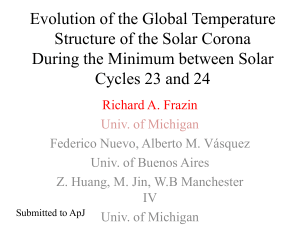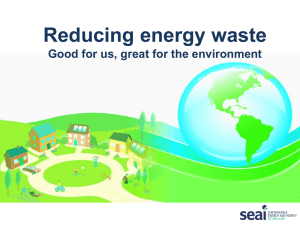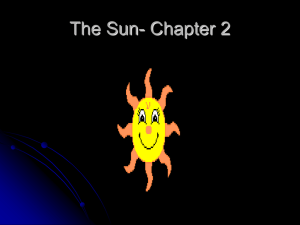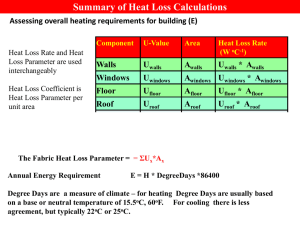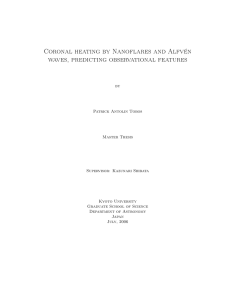Searching for Alfvén Waves - Harvard
advertisement
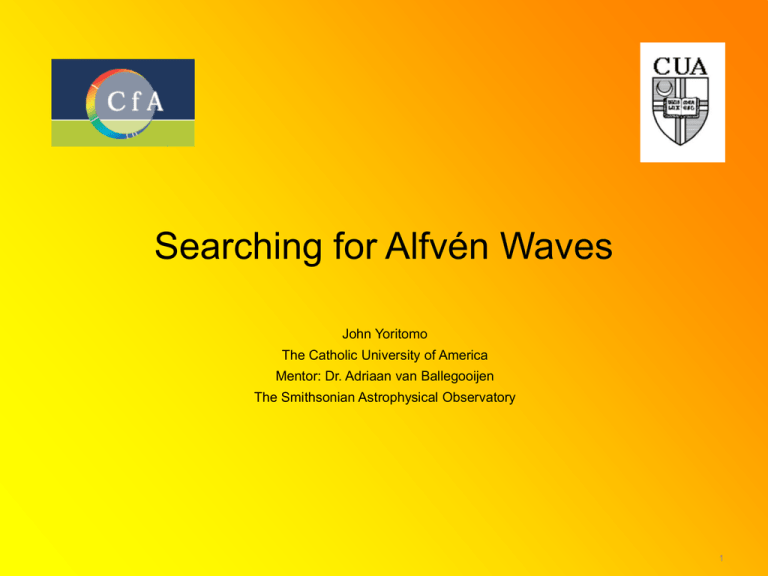
Searching for Alfvén Waves John Yoritomo The Catholic University of America Mentor: Dr. Adriaan van Ballegooijen The Smithsonian Astrophysical Observatory 1 Coronal Heating Problem • Walter Grotrian in 1939 and Bengt Edlén in 1943 discovered that the temperature in the corona is a few million degrees Kelvin. • If the only process involved was thermal in nature, this would violate the second law of thermodynamics, namely that heat cannot flow from a colder area to a hotter one. • There must be some other physical mechanism that heats the corona to such high temperatures. Two Main Heating Theories • Direct Current (DC) Heating Models – Magnetic Reconnection, i.e. dissipation of magnetic stresses – Nanoflares – First developed by Eugene Parker (1972) • Alternating Current (AC) Heating Models – Waves – Transverse Alfvén Waves are created in the photosphere and travel up to the corona where they dissipate their energy – First proposed by Evry Schatzman (1949) and Hannes Alfvén (1947) – Random footpoint motion QuickTime™ and a YUV420 codec decompressor are needed to see this picture. Magnetohydrodynamic (MHD) Waves Phase velocity perpendicular vph,x/vA • Three modes – Fast mode: compressional Alfvén waves, modified by plasma pressure – Slow mode: sound wave, modified by the magnetic field – Intermediate mode: Alfvén Waves • Alfvén Waves – Transverse waves (like waves on a string). – Incompressible, so no density or pressure changes related to it. – The magnetic tension force is the sole driving force. image: http://www.aldebaran.cz/astrofyzika/plazma/waves_en.html My Research • Look at an active region with SDO/AIA images to find signs of transverse motions that may be evidence for Alfvén waves. • Using the Alfvén wave heating model developed by van Ballegooijen et al. (2011), create models of certain coronal loops. • Compare the models to the observations. 6 Active Region: May 19, 2012 QuickTime™ and a YUV420 codec decompressor are needed to see this picture. 7 Observations: Loop 5 Selected QuickTime™ and a YUV420 codec decompressor are needed to see this picture. Intensity vs. position and time Time 8 Observations: Loop 5 Selected Plot of position of max intensity for reach time step 9 Modeling Magnetic Loops Magnetogram • Using Coronal Modeling System (CMS2) software, a potential field model is created from a magnetogram and the corresponding magnetic synoptic map. • From this potential field, models of coronal loops are made. Synoptic Map 10 Potential Field Model Contour of magnetogram. Red is positive polarity, green is negative polarity Overlaid image of active region in 171 Å 11 Potential Field Model 5 3 2 1 4 Included five field lines traced through potential field 12 Braid Program • Taking the loops from the CMS2 program, 3D MHD models for the Alfvén waves in the loops are constructed. • Simulations yield estimate for heating rate Q0 along with other parameters. Interactions of magnetic flux tube footpoint with convective flows in the photospheric granules. The flows distort the shape of the flux tube, generating transverse motions upward into the corona. Cross-sectional contour of different patterns of motion along any part of the loop. Arrows point at the driver modes of the footpoints in the photosphere. Images: van Ballegooijen et al.13 (2011) Various Quantities Describing Model 5 The X axis of all plots is distance in Alfvén travel time: 14 Movie Display of Heating Rate Photosphere Corona Photosphere QuickTime™ and a GIF decompressor are needed to see this picture. • Displays the heating produced by the Alfvén waves • Top row shows side view with respect to the x position; middle shows side view for y position • Blue arrows indicate where the transition region is. • Bottom row shows cross section of heating rate at various locations. • Waves coming from both sides; one can clearly see reflection at both transition regions. 15 Results for Loop Model 5 • Results for minimum heating rate, Qmin, and exponent, m, are put back into another part of the CMS2 program. A new temperature and density are calculated with these parameters using a one dimensional loop model. Initial temperature determined by RTV scaling laws Nu is the damping rate (s-1) m is exponent in expression for time averaged heating rate Q0 rstart is height in solar radii, i.e. 0.03 solar radii above the photosphere 16 Coronal Loops in Center of Region We wanted to see at what critical height the loops become thermally unstable. 17 Coronal Loops in Center of Region As height increases, the heating rate and density decrease. Interestingly, F9, F7, and F5 are thermally stable, even as the temperature goes below 2 MK. Loops at these heights that are not in the center become thermally unstable. One possible explanation for this stableness is that these loops are rooted in strong fields (i.e. sunspots), preventing thermal non-equilibrium from occurring. 18 Results from Models • There is a large increase in temperature and Alfvén speed for loops as they go from the photosphere to the corona. Also a large decrease in heating rate and density. • The heating rate is intermittent in the loops, and there is strong reflection at the transition region. • Thermal non-equilibrium is reached at lower heights in the periphery of the active region than in the center. • As height increases, the heating rate and density decrease for center loops. 19 •Perhaps the biggest obstacle for any coronal heating model is to match the model predictions to the actual observations. 20 Relating the Model to Observations Top figure is a cutout of previous plot of loop 5. Bottom figure is plot of the heating rate variations as function of time and position along the loop. Position is in Alfvén travel time. 200 2.6 1000 Time (s) 2000 2.4 21 Conclusions • There are signs that some loops may have a long wavelike structure with short waves superimposed onto it. This agrees with the predictions for the loop heating from the model. • There are clear visual signs of movement in the coronal loops, but whether these movements are Alfvén waves is yet to be conclusively decided. • Our model has produced interesting results that looks towards an agreement with observations, but it is still a long ways off. • More work needs to be done on making the model more realistic, and especially on extracting information from the observations. 22 The Search Continues! 23 Special Thanks • • • • Aad van Ballegooijen Mah Asgari-Targhi Kathy Reeves and Ed DeLuca Trae Winter, John Sattelberger and other SAO Solar Staff • Fellow Solar Interns and Astro Interns and Admins • NSF REU Grant ATM-0851866 24 Further Reading • “Heating of the Solar Chromosphere and Corona by Alfvén Wave Turbulence” (2011) by A.A. van Ballegooijen, M. Asgari-Targhi, S.R. Cranmer, and E.E. Deluca • “Model for Alfvén Wave Turbulence in Solar Coronal Loops: Heating Rate Profiles and Temperature Fluctuations” (2012) by M. Asgari-Targhi, A.A. van Ballegooijen. • Physics of the Solar Corona (2004), Chapters 7-9, by M. Aschwanden • Solar Magnetohydrodynamics (1982), Chapters 1,2,4,6 by E.r.Priest 25
